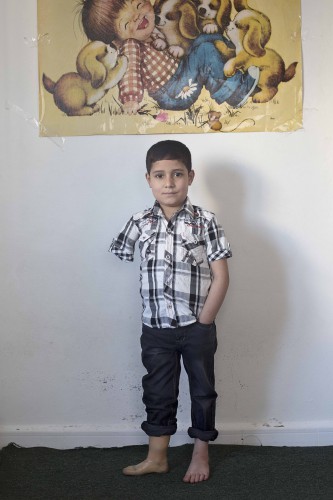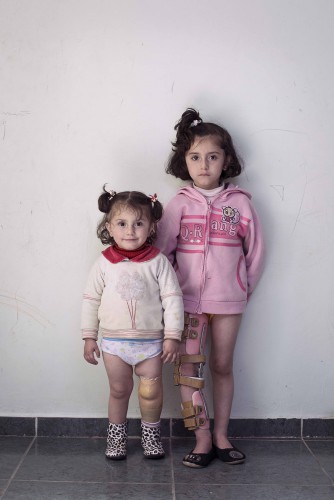Syrian Collateral
It is a paradox of war that the injury of a single person makes the biggest impression on us; the one whose face we can see, the one whose name and fate we can actually recall. The bigger the number of the victims the less we are touched emotionally. In 2014 and 2015 Kai Wiedenhöfer … Continue reading Syrian Collateral →

The Resistance Square in the center of Kobane after heavy fighting between Kurdish YPG militia with the support of the US Air Force and fighters of the Islamic State which raged for five months till February 2015.
Kobane, Syria, March 2015.

A'amar Yassir Salamat, 8,from al-Harak in the Dera'a province. He was injured on July 24, 2012, when a rocket hit a shelter with hundreds of people. Six children and a woman were killed in the incident, 10 were injured. His arm and half of his foot were severed by the explosion. He spent a week in a field hospital. Then he was carried for five kilometers on a stretcher across the border. In Jordan he was amputated twice because of an infection which had already occurred in Syria due to a lack of any antibiotics. He spent two months in the Islamic Hospital in Amman. Then a French organisation brought him to Paris where his stump was cleaned and a further operation was done on his leg bone. He received a prothesis in France which works very well. The one he received in Jordan from Handicapped International was inefficient. The whole family is in Jordan. Two sons of A'amar's aunt were executed by the Syrian regime, one was hanged (picture). Her daughter Rukia, 13, lost an arm in the same incident. Her husband is in prison and hasn't been heard of for two years now. A sister of A'amar died of leukemia. She couldn't go to Damascus for chemotherapy for four months because the Assad troops besieged al-Harak. Irbid, Jordan, 2014.

Duwa'a, 2, & Schahd, 5, al-Sarchan Their father Hassan, 30, has five children and worked as taxi driver between Amman and Damascus. On April 13, 2013, at 11am a rocket hit the fourth floor of his uncle's house where they lived. They had moved there after their home came under control of the Syrian army. As soon as the Syrian army moved in all people left the village.He was on the third floor when the rocket hit the balcony and then smashed through three walls and injured the daughters badly in the bathroom were they were playing. 22 rockets were shot in less than an hour. The day before the FSA had captured a nearby checkpoint and killed all the soldiers there. Hassan took Schahd with his uncle's motorbike to a nearby field clinic of the FSA. She had a big shrapnel wound on the knee. He didn't know anything about Duwa'a fate then. She was brought by car to the same clinic. Her lower leg was cut off by a shrapnel and the stump was sewn. Two days later she was brought to Ramtha in Jordan and from there to the al-Jasira Hospital in Amman.A transplant is made for the stump. The prosthesis was provided by Doctors Without Borders (MSF), they will also perform the next operation. Schahd spent one and a half months, Duwa'a three months in the clinic of Syria Cross Borders. Their father visited the girls once a week as transport is too expensive for their budget.Now they are waiting for the next operation, afterwards they want to return to Dera'a. The 125 JD for rent is paid by the father. Two of Hassan's brothers were arrested and there were no news for one and a half years. He was arrested himself for five days and his car was torched by the Syrian customs authorities. The oldest child can't go to school as it is too far and they have no money for the bus. Amman, Jordan, March 2014.
0 / 0
It is a paradox of war
that the injury of a single person
makes the biggest impression on us;
the one whose face we can see,
the one whose name and fate
we can actually recall.
The bigger the number of the victims
the less we are touched emotionally.
In 2014 and 2015 Kai Wiedenhöfer photographed for five months Syrian war wounded. Currently every weak 6 000 Syrians are injured. Syrian Collateral depicts forty of them in calm portraits which are complemented by long captions describing in detail each injureds fate. The portraits are combined with large panoramic landscapes of destroyed Syrian cities mostly Kobane. The injured and panoramas are interrupted by double paged fact sheets which provided the reader with basic figures about the damage which is done to Syria. For example the destruction of 2,1 million homes. Syrian Collateral is a quiet compendium of the most horrific conflict in our time.


